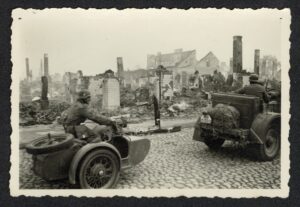 “The morning of 1 September greeted us with the roar of the engines of a low-flying plane. It wasn’t even six o’clock as people ran out of their homes. Some swore they saw black crosses on the wings. They were not believed: how could a German plane have got here, near Białystok, so early? (…) There was a commotion in the town. Women were crying, young people were full of optimism, convinced that the war had ended with victory. According to radio announcements, the border battle was continuing. It’s all-out war,” recalled 13-year-old Staszek Kubala. His father Józef, the head of the Wasilków Primary School, went to war, from which he never returned. Although he was urged to leave his unit, lay down his arms, and return home, his honour did not allow him to abandon his soldiers. He ended up in Soviet captivity and, along with thousands of other Polish officers, was murdered at Katyn. During his last telephone conversation, which took place on around 10 September, he asked his son to look after his siblings and help his mother. Staś kept his word. Although he had the chance to avoid deportation, he remained with his family, sharing at the same time the dramatic fate of the hundreds of thousands deported to Kazakhstan. When the hope of fighting the German enemy arose, he decided to join Anders’ Army. As his mother told him: “[t]his is perhaps the only chance for at least one of us to survive.”
“The morning of 1 September greeted us with the roar of the engines of a low-flying plane. It wasn’t even six o’clock as people ran out of their homes. Some swore they saw black crosses on the wings. They were not believed: how could a German plane have got here, near Białystok, so early? (…) There was a commotion in the town. Women were crying, young people were full of optimism, convinced that the war had ended with victory. According to radio announcements, the border battle was continuing. It’s all-out war,” recalled 13-year-old Staszek Kubala. His father Józef, the head of the Wasilków Primary School, went to war, from which he never returned. Although he was urged to leave his unit, lay down his arms, and return home, his honour did not allow him to abandon his soldiers. He ended up in Soviet captivity and, along with thousands of other Polish officers, was murdered at Katyn. During his last telephone conversation, which took place on around 10 September, he asked his son to look after his siblings and help his mother. Staś kept his word. Although he had the chance to avoid deportation, he remained with his family, sharing at the same time the dramatic fate of the hundreds of thousands deported to Kazakhstan. When the hope of fighting the German enemy arose, he decided to join Anders’ Army. As his mother told him: “[t]his is perhaps the only chance for at least one of us to survive.”
As a result of the Second World War, Poland suffered the greatest biological losses of all countries: 220 people lost their lives per every thousand inhabitants. Staś Kubala’s family survived. They reunited in 1947 in Wasilków. Józef Kubala’s name is engraved on one of the plaques in the Katyn Memorial at the Sybir Memorial Museum.
Photo: German soldiers in destroyed Grajewo, mid-September 1939. From the Sybir Memorial Museum collection (collection of Maciej Wojski).



